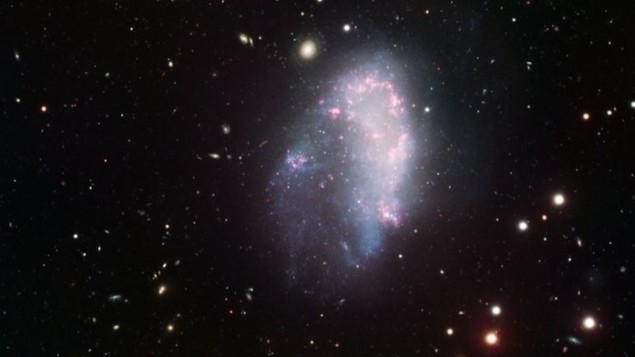Dwarf galaxies appear to be missing dark-matter halos
16 Aug 2022
Holding together The dwarf galaxy NGC1427A is in the Fornax galaxy cluster. Observations of the distortions of the galaxy are not in line with the presence of a dark matter halo. (Courtesy: ESO)
A study of the gravitational distortion of dwarf galaxies appears to support a theory of modified gravity rather than the existence of dark matter – the latter being a key component of the Standard Model of cosmology.
Dark matter is a hypothetical substance that is believed to comprise about 85% of the matter in the universe. Its gravitational influence prevents large objects such as galaxies from flying apart as they rotate and evidence for dark matter can also be found in the cosmic microwave background – radiation that was created shortly after the Big Bang. However, despite the abundance of indirect evidence for dark matter, dark matter particles have never been detected. As a result, other theories exist to explain the behaviour of galaxies, including those that modify the law of gravitation.
Dark matter is thought to clump together in halos – large regions of dark matter that are held together by gravity. Halos are believed to play important roles in the development and evolution of galaxies such as the Milky Way, which itself appears to be surrounded by a dark matter halo.
Vulnerable to deformation
In this latest research, Elena Asencio at the University of Bonn and colleagues have looked for evidence of dark-matter halos around dwarf galaxies. These are the smallest and most common types of galaxy and can be found in clusters or surrounding larger galaxies such as the Milky Way. Because of their lower masses, dwarf galaxies are especially vulnerable to deformation by the gravitational forces exerted within a cluster or by a nearby larger galaxy. However, these distortions would be reduced if the dwarf galaxies were enveloped in dark-matter halos.
To explore this idea, Asencio and colleagues examined telescope images of the Fornax Cluster, which abounds with dwarf galaxies. The images were taken by the European Southern Observatory’s Very Large Telescope. The astronomers then tried to reproduce the observations using computer simulations based on the Standard Model of cosmology – which includes dark matter.
Surprisingly, this approach was not successful. Indeed, the team’s calculations suggest under the Standard Model, the Fornax dwarfs would be torn apart by gravity.
MOND hypothesis
Eager to discover what was holding the galaxies together, the team did more simulations – this time without dark matter, and instead using the Modified Newtonian Dynamics (MOND) hypothesis. First developed by the Israeli physicist Mordehai Milgrom in the 1980s, MOND dictates that gravity becomes stronger in the regime of low acceleration. This modification reproduces the rotational observations of galaxies but reverts to Newton’s law in high acceleration environments like the solar system.READ MORE

Unlike dark matter, MOND was able reproduce the Fornax observations, casting cast fresh doubt on the existence of dark matter. Indeed, this is not the first study suggesting that the dynamics and evolution of some galaxies cannot be explained by invoking dark matter – and the number of such observations is growing. However, MOND and other theories that modify gravity have their own theoretical and observational shortcomings – so it is probably too early to give up on a Standard Model that incorporates dark matter.
The research is described in Monthly Notices of the Royal Astronomical.
Sam Jarman is a science writer based in the UK.
FROM PHYSICSWORLD.COM 18/8/2022

Δεν υπάρχουν σχόλια:
Δημοσίευση σχολίου